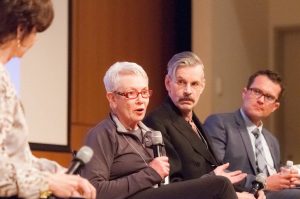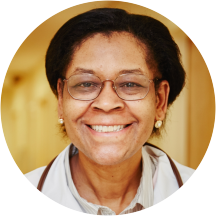First published by IVN
April 11, 2018
I lost a friend last week, Bonnie Reiss. She died of lung cancer at 62. The disease spread quietly until it emerged full force a year ago. Its grip was relentless. And it would not let go.
Bonnie was a political woman, with a long resume of remarkable accomplishments. Most recently, she’d architected and led a new policy institute at the University of Southern California, named for its benefactor, Arnold Schwarzenegger, the swashbuckling movie star and former governor of California.
Bonnie served in Arnold’s government as Secretary of Education and was an inner circle advisor for this independent leader who, while elected as a Republican, never towed a party line. For this, Bonnie was well suited, as she didn’t care much for the partisan culture. She’d seen it all. She knew how destructive it could be.
Bonnie had a rare talent for handling swashbuckling independent men, particularly iconic and famous ones. Arnold’s larger-than-life personality and style fit easily into her world, having cut her political teeth as a young lawyer working for Ted Kennedy, which led to a lifelong collaboration and friendship with members of the Kennedy family.
She was tough and savvy, she’d made her bones in the testosterone-filled world of government and politics. I’m sure she paid a price for that toughness, but she had an outrageous sense of humor and a deep compassion for people.
As I came to know Bonnie over the last six years, I could see the many ways that Arnold relied on her to hone the mission of the Schwarzenegger Institute — an eclectic and transpartisan blend of process and policy issues ranging from alternative energy to alternative political systems.
She shaped a unique agenda for these postmodern political times. This was not altogether easy, particularly when it had to fit into the filming schedules of a variety of Terminator sequels and prequels.
In my own way, I had come to rely on Bonnie, too. As an early architect of the independent political movement, I’d been in many go-against-the-grain situations, and saw that Bonnie had a genuine feel for political disruption, particularly the kind that crossed ideological lines.
We’d first met at the founding conference of the USC Schwarzenegger Institute for State and Global Policy in 2012, when she’d graciously given me a VIP seat to witness the event.
Because political reform was one of the Institute’s five interest areas and because Independent Voting, through its California chapter, Independent Voice, had been a force in the Schwarzenegger coalition that backed and ultimately enacted a Top Two nonpartisan primary system, I landed on the invitation list.
I was glad that Arnold was investing his hard-won political capital in promoting reforms like open primaries, but hadn’t expected to find that there was a figure in his celebrated vortex like Bonnie. I knew right away that she was a singular character.
Over the next six years, we created a chain of bi-coastal collaboration. I was a guest speaker at several Schwarzenegger Institute events. I brought Bonnie and her team into the chaotic world of the independent movement and the burgeoning political reform universe.
Together, with the Morrison Institute for Public Policy at Arizona State University, we created a trilateral consortium to study and promote the rise of the independent voter. We met periodically over lunch at USC to scheme out overlapping strategies.
Once, when I was feeling despondent and angry about how universally male and macho the political scene was, I called her. She invited me to lunch at the swanky Hotel Bel-Air, where she was holed up for several days meeting with the heads of alternative energy companies (a prong of Arnold’s agenda).
I arrived 15 minutes early and was seated at a banquette near a half-dozen bejeweled Iranian beauties. Vintage Beverly Hills.
Suddenly, a commotion at the doorway drew everyone’s attention. Bonnie had arrived with Boo, her omnipresent terrier, in tow. She waved gaily and presented herself at our table, seating Boo in a chair with his head perched gamely over a plate, as if he were about to order a cobb salad and a glass of Prosecco.
We got down to business and I glumly told her “the tale of the tape,” a catalogue of arrogant male behavior in which collaboration was a commodity traded over a beer or a steak, and “little ladies” (I was in John Wayne mode) were grudgingly tolerated. The marginalizing of independent voters combined with the male elitism creeping into the movement was a toxic brew.
Bonnie and I were nearly the same age, with long but quite different career paths. She was the insider, I was the outsider. But, I knew she would understand the dynamics of being a woman in that mix. She listened sympathetically, told me not to worry about it, and instructed me to keep going on the path I was on.
“This independent voter thing is big,” I remember her saying. “Nobody gets it the way you do. One day they will all have to come to you.”
That was Bonnie. No victim talk. No wasted words. Always looking ahead. Always leading.
When it was time for dessert, Bonnie’s team joined us for coffee. Conyers Davis and Mebus Behrle, two of the most capable and caring political people you’ll ever come across, sat down with us. It was the first time the four of us had hung out together, and we chitchatted about the upcoming Senate race in California (happy talk) and the looming presidential contest (unhappy talk).
I was struck at the time by how devoted to Bonnie both Conyers and Mebus were, and I loved them instantly for that. When I got ready to leave, Bonnie stood up, walked over to me and put her arms around me. We hugged and she whispered in my ear, “my sister.” That was all I needed to hear.
A year later, I presented Bonnie with an Anti-Corruption Award at the annual awards ceremony of the Independence Clubs of New York City. She was already sick by then and couldn’t make the trip.
Instead, she sent a video recording thanking Cathy Stewart, the Coordinator of the Clubs, and me for the award. We played it at the event and there she was, in her garden at home in Malibu, looking fervently alive and excited about all the plans we’d made to pry open the calcified political system.
The audience cheered.
What an indescribable loss. And, I must say thank you, Bonnie, for your friendship, your spirit, and your wisdom. I can never repay the debt. I will always remember you. Goodbye, my sister.
Post Script: USC Schwarzenegger Institute Tribute to Bonnie Reiss here.
* * *


